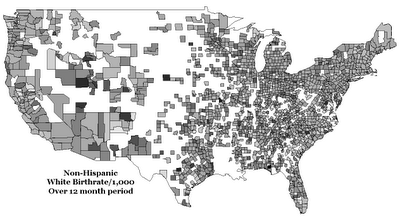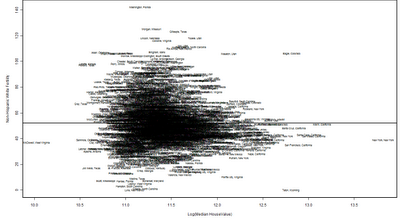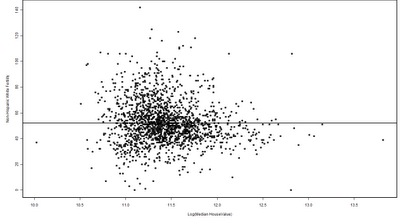|
Tuesday, August 11, 2009
I've been poking around the Census data sets for a few days now. I want to merge them with the longevity stuff soon, but while was at it I decided to check to see how variation in geography related to variation in fertility. You can go to the GSS and see all sorts of national trends, but I thought a county-by-county view would be of interest. Click the images for bigger versions. The fertility is defined as "women with births in the past 12 months; rate per 1,000 women." Coming out of the American Community Survey. All the data are for Non-Hispanic white women.
  
Wednesday, June 17, 2009
A reader pointed me to the Population Reference Bureau which has total fertility rates for women broken down by economic fifths. Unfortunately these data are limited to developing countries, but reader might be interested in any case. In no case do the women of the richest fifth have a higher fertility than the women in the poorest fifth.
Related: Differences in fertility by class internationally. Labels: fertility
Tuesday, October 14, 2008
 This chart shows the proportion of white men and women age 50 and over who have 0, 1, 2, etc. children, up to 7. I got this from the GSS via CHILDS. I dropped 8 or more since that's unbounded, but very few had that many (on the order of 1%). Red is female, and navy male. This chart shows the proportion of white men and women age 50 and over who have 0, 1, 2, etc. children, up to 7. I got this from the GSS via CHILDS. I dropped 8 or more since that's unbounded, but very few had that many (on the order of 1%). Red is female, and navy male.
Saturday, May 31, 2008
Walker's World: French births soar:
The second development to note is that INED, France's National Institute of Demographic Studies, has done some detailed research and concluded that France's immigrant population is responsible for only 5 percent of the rise in the birthrate and that France's population would be rising anyway even without the immigrant population. A few points. First, even if there is convergence differentials still do matter. One thing I noted when surveying data on Mormon fertility is that though it has converged with non-Mormon fertility, the "floor" still usually remains higher than that of local non-Mormons. I'm not worried about a Mormon future of course because it is also a religion with a relatively high defection rate, but long term persistence of small differences do matter. Second, projecting to the year 2100 as many do today is very problematic. In the late 19th century some bureaucrats in the Ottoman government were relieved as the Christian Balkan provinces fell away through independence or assimilation into the Austro-Hungarian monarchy. The reason being the fact that Christians had higher fertility than Muslims; something most Muslims and Christians today would find a very peculiar worry. In After Tamerlane there is a reference to a racial triumphalist demographer writing in 1900 about the "fact" that in the year 2000 there will be 1.5 billion whites and only 400 million Han Chinese. Finally, variance matters. Note: Germany is something of an oddity in this. In most countries with low fertility, young women have their first child late, and stop at one. In Germany, women with children often have two or three. But many have none at all. Italy and Germany might both have low expectations in regards to the number of children a woman may have in her lifetime, but the shape of the distribution may matter a great deal if fertility is heritable to any extent (straight out of Genetical Theory here). Heritability need not be physiological; rather, it might be cultural and psychological propensities transmitted to the next generation. But if the data above hold one might expect German fertility to bounce back faster than Italian because a subset of the German population exhibit pro-natalist sentiments. (H/T Talk Islam) Labels: Demographics, fertility |



